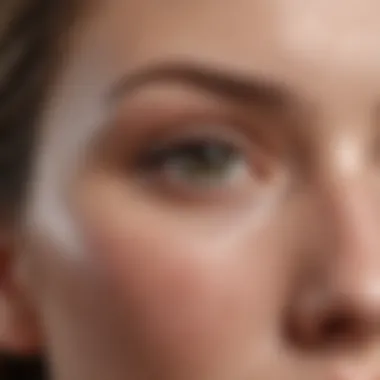Understanding and Managing Zits on the Butt


Intro
Dealing with skin issues can often be a vexing challenge. Among these, one topic tends to float under the radar but still impacts many—zits on the butt. It's not something commonly discussed, and this silence can cause feelings of embarrassment for those affected. We’ll dive into the underlying factors that contribute to this condition, highlighting the role of hygiene, clothing choices, and diet as well as effective ways to manage and prevent these pesky blemishes.
Understanding zits on the butt involves peeling back layers—literally and metaphorically. In the ensuing sections, we’ll shine a light on actionable tips and tricks, focusing on how individuals can embrace better skin health with confidence. The myths surrounding these skin irritations often amplify shame, but knowledge serves as a powerful antidote, allowing people to take control of their dermatological dilemmas.
"Cleanliness is close to godliness"—a quote that holds as much truth for your butt as it does for the rest of your body.
In this article, we aim to transform how readers view their skin issues, encouraging a proactive approach to skincare and dispelling the stigma tied to body blemishes.
As we move forward, we’ll touch on fashion trends, skincare routines, and the best products available for addressing zits on the butt. It’s high time we start talking about these concerns and equip ourselves with knowledge that leads to effective management.
Prelims to Zits on the Butt
Zits on the butt, often a topic whispered about in social circles and seldom addressed directly, are more common than many may think. While some individuals might brush off these skin blemishes as trivial, they hold significance worth discussing, particularly concerning personal hygiene, body image, and skin health. Far from being a mere annoyance, butt zits can shed light on a range of underlying factors that impact overall well-being. Understanding these aspects is vital, especially for those who experience them frequently.
Definition and Understanding
On a fundamental level, zits on the butt, medically referred to as folliculitis or acne mechanica, occur when hair follicles become inflamed or blocked. This inflammation usually manifests as red, painful bumps that may contain pus. While primarily affecting the buttocks, these zits can also appear in areas where there is friction—such as the thighs or lower back. Often, they arise due to a combination of factors, including perspiration, hormonal shifts, and the kind of materials that your clothing is made of. By recognizing these aspects, individuals can take the first step toward effective management.
Why It Matters
The significance of addressing zits on the butt goes far beyond surface-level aesthetics. For many, these blemishes can affect self-esteem and body confidence. Nobody enjoys the feeling of discomfort or embarrassment when wearing a swimsuit or fitted clothing. Delving into this topic not only offers practical insights for better skin management but also confronts social taboos surrounding body imperfections.
Moreover, understanding zits on the butt can help in identifying any potential underlying health issues. For example, persistent flare-ups might suggest the need for a deeper investigation into hygiene practices, clothing choices, or hormonal imbalances. Ignoring them could lead to exacerbated skin conditions, so being proactive is invaluable. In essence, properly understanding this issue paves the way for healthier skin, improved well-being, and a boost in confidence for many individuals.
Causes of Zits on the Butt
A tight-lipped topic in the realm of skin health is the variegated origins of those pesky zits that crop up on the buttocks. Often brushed aside, this area deserves some attention as it can signal various underlying issues. Understanding the causes not only arms individuals with knowledge but also paves the way for better preventive and treatment strategies. From hormonal fluctuations to the food we consume, a multitude of elements contribute to this skin dilemma. Therefore, let’s dig into the specific causes and see how they play a role.
Hormonal Changes
Hormonal changes are often a significant player in the appearance of zits on the butt. This can happen during certain phases in a woman’s life like puberty, menstruation, or pregnancy when hormone levels fluctuate dramatically. When your hormones are on a rollercoaster ride, the skin can overproduce oil, clogging pores and leading to breakouts. It’s essential to be aware of these shifts—anytime your body is experiencing changes, the skin tends to react. Incorporating a regular skincare routine that stabilizes these fluctuations can be a game-changer.
Bacterial Infections
Bacterial infections are another common culprit behind zits on the butt. The skin is home to bacteria naturally. However, when there’s an overgrowth of certain types, it can lead to inflammation and acne. Areas like the buttocks, which are often covered and subjected to constant friction, create conditions ripe for bacterial proliferation. This makes it crucial to maintain cleanliness in this area, using antibacterial soaps or lotions where necessary.
The skin’s natural barrier is protective, but it can become compromised. A bit of extra care can go a long way.
Friction and Sweat
Friction and sweat are not just nuisances; they can actually work hand in hand to exacerbate skin issues on the butt. Activities such as sitting for prolonged periods or wearing tight clothing can create friction that irritates the skin, leading to inflammation and zits. Sweat can also trap dirt and oil, blocking pores, particularly during hot weather or exercise. Selecting breathable fabrics and taking regular breaks when sitting can help ease this situation significantly. As common as this issue is, it often flies under the radar, yet the right moves can minimize discomfort.
Dietary Factors
What one consumes does not simply affect overall health—it plays a direct role in skin health as well. A diet high in sugars, processed foods, or dairy can trigger acne breakouts in some individuals. While this can vary from person to person, it’s essential to remain mindful about what is being consumed. Foods rich in antioxidants and omega-3 fatty acids can help mitigate inflammation and support skin health. It’s worth taking a step back and assessing eating habits; even small changes can yield promising results in managing zits on the butt.
Prevention Strategies


Preventing zits on the butt is as crucial as addressing them once they show up. Understanding what actually leads to breakouts can empower individuals to take proactive steps, minimizing the chances of recurrence. By putting prevention strategies into action, not only can one avoid the discomfort associated with this issue, but it can also lead to a boost in overall confidence and well-being.
Hygiene Practices
Good hygiene is foundational when it comes to preventing zits on the butt. Cleanliness contributes to a healthy skin environment, keeping bacteria at bay and minimizing oily buildup. Regularly washing the area with a gentle soap helps remove impurities.
- Daily Cleansing: Make it a habit to cleanse this area daily, perhaps during showering. Look for mild, fragrance-free soaps so you aren't introducing potential irritants.
- Exfoliation: Gentle exfoliation can remove dead skin cells that may clog pores. Consider using a soft washcloth or a light exfoliating scrub. Just don’t overdo it—too much exfoliation can irritate the skin.
Remember, maintaining cleanliness isn’t just about washing; it also involves drying properly. Bacteria love damp environments, so patting the area dry gently after a wash is vital. Having a cool, airy environment can also help in drying out the skin effectively.
Choosing the Right Apparel
The clothes you wear play a significant role in skin health. Opting for the right apparel can significantly decrease the chances of zits forming.
- Stay Loose: Tight clothing can cause friction and trap sweat, both of which can lead to zits. Loose-fitting cotton or moisture-wicking fabrics are typically more comfortable and breathable.
- Natural Fabrics: Stick to natural fibers like cotton and bamboo, which allow for better airflow. Synthetic fibers, on the other hand, can often exacerbate sweating and may cause irritation.
- Change Regularly: Avoid leaving damp or sweaty clothes on for too long. After workouts, changing into dry clothes can prevent moisture buildup that can lead to breakouts.
Managing Sweat and Friction
Friction and sweat can be real enemies in the battle against zits on the butt. Here are some ways to keep them in check:
- Talcum Powder: Using an unscented talcum powder can absorb moisture and reduce friction. It’s helpful especially in hot weather or during physical activities.
- Frequent Breaks: If sitting for prolonged periods, take frequent breaks to decrease friction. Shifting your position or taking a short walk can help.
- Effective Workouts: When exercising, try not to skip on breathable fabrics that keep sweat away from your skin.
Avoiding Irritating Products
Many products can cause irritation leading to zits, so it's important to choose wisely. Pay attention to what goes onto your skin:
- Fragrance-Free: Products that are heavily scented often contain chemical irritants. Opt for fragrance-free soaps and lotions that reduce the likelihood of irritation.
- Non-Comedogenic: Look out for terms like "non-comedogenic" on creams and lotions, as these are designed to not clog pores.
- Patch Testing: When trying new products, doing a patch test by applying a small amount in a less noticeable area is smart. This can reveal any potential adverse reactions prior to fully using a product.
Remember, good prevention strategies not only help in managing zits on the butt but also contribute to overall skin health.
By focusing on hygiene, clothing choices, managing sweat, and selecting appropriate products, individuals can significantly diminish the chances of experiencing discomfort related to this common issue. Proactive measures are always easier than dealing with a breakout.
Treatment Options
Treatment options are a crucial part of managing zits on the butt, as they enable individuals to address and alleviate this common skin issue effectively. Often overlooked, the right treatment can make a significant difference in skin health, helping to reduce discomfort and prevent further outbreaks. Understanding what options are available ensures that you're equipped with knowledge to make informed decisions tailored to your needs.
Topical Treatments
Topical treatments are often the first line of defense when dealing with zits on the butt. These products are applied directly to the skin and can take various forms, including creams, gels, and ointments. One of the most well-known topical treatments includes benzoyl peroxide, which is renowned for its antibacterial and exfoliating properties. This ingredient can help clear clogged pores and reduce inflammation, which is often central to acne formation.
Other effective options might include:
- Salicylic Acid: This beta hydroxy acid helps to exfoliate the skin, clearing away dead skin cells that can clog pores.
- Retinoids: These vitamin A derivatives promote cell turnover and can prevent pores from becoming blocked.
- Tea Tree Oil: A natural remedy with antibacterial qualities, tea tree oil may provide relief for mild cases.
While using these treatments, it is essential to apply them correctly and give the skin some time to respond. Overuse can lead to irritation, so starting with a small amount and gradually increasing is often advisable.
"Using the right treatment requires patience. Results don’t always come overnight."
Oral Medications


In some instances, zits on the butt may necessitate more potent solutions, such as oral medications. These options are typically discussed with a healthcare provider, who can assess your specific condition and recommend the best course of action.
Common oral medications include:
- Antibiotics: These are intended to reduce inflammation and combat bacteria. They can be particularly helpful for those dealing with larger cysts or significant outbreaks.
- Hormonal Treatments: For some women, hormonal imbalances can contribute to skin issues. Birth control pills, for example, may help regulate hormone levels, thereby reducing breakouts.
- Isotretinoin: A more extreme measure, this medication is usually reserved for severe cases. It works by decreasing oil production in the skin and markedly reducing the likelihood of future breakouts.
Each of these medications comes with its potential side effects and risks, so a thorough consultation with a dermatologist is crucial before starting any kind of oral treatment.
Home Remedies
If you're looking for more natural approaches, several home remedies may help manage zits on the butt. While these solutions might not work for everyone, they can offer comfort and relief. Here are a few popular options:
- Aloe Vera: Known for its soothing properties, applying aloe vera gel can help reduce redness and inflammation.
- Apple Cider Vinegar: This can act as an astringent, helping to balance skin’s pH. Diluting it with water and applying it with a cotton ball is a common practice.
- Warm Compresses: To ease discomfort, applying a warm compress can help open up pores and promote healing.
- Honey: A natural antibacterial, honey can be applied as a spot treatment.
When considering home remedies, remember that it may take time for results to show. It's also wise to conduct a patch test before applying anything new, especially for those with sensitive skin.
In summary, a combination of topical treatments, oral medications, and home remedies offers a plethora of options for dealing with zits on the butt. It’s essential to personalize your approach and, when in doubt, consult with a healthcare professional to find what works best for you.
When to Seek Professional Help
Knowing when to seek professional help is crucial when dealing with zits on the butt, or any skin issue for that matter. Many individuals might brush off their concerns, thinking they can handle it themselves, but certain signs warrant contacting a healthcare provider. Recognizing these can prevent minor irritations from escalating into more significant problems.
Identifying Serious Conditions
Not all zits are created equal. Some blemishes might be straightforward acne, while others could signal underlying health issues such as folliculitis or even more severe skin conditions like hidradenitis suppurativa. Here are some red flags to watch out for:
- Persistent Bumps: If zits stick around longer than they should, say a week or more, it's time to take action.
- Painful or Swollen Areas: Discomfort or swelling might indicate an infection rather than just regular acne.
- Changes in Color or Texture: If a zit turns darker or becomes scaly, it may require a professional's eyes.
- Fever or Systemic Symptoms: This could indicate an infection that likely needs immediate care.
"Ignoring persistent issues can lead to compounded problems, making an early visit to a dermatologist a wise choice."
Understanding these signs is the first step. They can help in distinguishing between a typical skin issue and a matter that needs urgent attention. Continuous or severe symptoms often reflect deeper challenges that at-home remedies won’t resolve.
Consultation with Dermatologists
When you recognize the flags mentioned earlier, consulting a dermatologist becomes important. Dermatologists are specialized in skin conditions and can offer tailored solutions that might not only relieve pain but also improve skin health.
Here are some benefits of seeking a dermatologist's advice:
- Expert Diagnosis: Experienced in skin-related problems, their knowledge can pinpoint the exact nature of the issue.
- Customized Treatment Plans: They can recommend treatments effective for your specific type of skin and condition, which may include things like prescription topicals or even therapy options.
- Preventing Future Breakouts: Not only can they help with current zits, but they also provide strategies to keep your skin clear in the long run.
- Peace of Mind: Just knowing you're addressing the issue with a professional can alleviate anxiety over skin conditions, allowing for a more positive body image.
So, while zits can feel like a nuisance, it's clear that some circumstances call for an expert's touch. Don't hesitate; the sooner you consult a professional, the more effectively you can manage your skin health.
Myths and Misconceptions
Understanding the myths and misconceptions surrounding zits on the butt is crucial for anyone dealing with this skin issue. Acknowledging these fallacies not only educates those affected but also helps combat the stigma associated with bodily blemishes. Many people suffer in silence, often believing misinformation that could potentially hinder their approach to treatment and prevention.
Blemishes Are Only Acne


One of the prevalent misconceptions is that all blemishes are simply acne. While acne is indeed a common cause of pimples, it’s not the sole reason behind zits on the butt. Skin conditions can arise from a variety of factors, such as folliculitis, which is the inflammation of hair follicles. This can happen due to friction or bacteria, often unrelated to acne itself.
Additionally, skin irritation can stem from other dermatological issues like keratosis pilaris or allergic reactions. Individuals may focus solely on treating acne, neglecting other important skin health aspects. This limited perspective can result in prolonged discomfort or worsening of the condition.
To better understand these distinctions, consider the various types of skin issues that can appear on the butt:
- Folliculitis: Often mistaken for acne, this condition presents as red bumps and can be triggered by tight clothing or shaving.
- Keratosis pilaris: Characterized by small, rough bumps, this skin condition is often hereditary and unrelated to the typical acne process.
- Contact dermatitis: This occurs due to an allergic reaction to products or fabrics that irritate the skin, leading to red and itchy patches.
By recognizing these different conditions, individuals can seek specific treatments more effectively and avoid the one-size-fits-all approach that often fails.
Only Teenagers Get Them
Another common belief is that only teenagers deal with zits on the butt. This misconception can perpetuate a sense of isolation for adults who may struggle with the condition. In reality, zits can occur at any age due to a variety of factors beyond adolescence. Hormonal fluctuations, different life stages, dietary changes, and new environmental factors all contribute to the development of these blemishes.
Adulthood often brings changes that can trigger skin issues, such as:
- Hormonal changes due to factors like pregnancy, menopause, or stress. These fluctuations increase oil production in the skin, leading to breakouts.
- Lifestyle choices, including diet and habits such as smoking, can also influence skin health. High-sugar foods or dairy may exacerbate skin problems.
- Aging: With age, skin cell turnover slows down, which can lead to a buildup of dead skin cells and blocked pores, resulting in zits or similar blemishes.
It's vital to demystify such beliefs and provide accurate information. Educating oneself about these issues can lead to better prevention and treatment strategies. Remember, zits can plague anyone, independent of their age, and addressing this outright remains an essential step in managing skin health effectively.
Ultimately, shedding light on these myths serves to empower those affected by zits on the butt, reminding everyone that they are not alone and that seeking out accurate information can pave the way for effective management.
Psychological Impacts
Understanding the psychological impacts of zits on the butt, or any skin condition really, sheds light on an often ignored but critical aspect of health. It is not just about the physical discomfort or the visible blemishes; it’s about how these skin issues intertwine with emotional well-being. For many, the presence of such imperfections can lead to self-doubt, social withdrawal, and even anxiety. Addressing these psychological facets is essential, as it encourages individuals to seek help and take proactive measures.
Self-esteem and Body Image
The journey of dealing with zits can be a tough pill to swallow. Self-esteem often takes a nosedive when one is faced with skin blemishes, especially in a world where appearance can overshadow other qualities. For instance, a woman might feel less attractive as she struggles with the sight of these spots during summer months when swimwear becomes inevitable. This may result in avoidance of outings or swimming altogether, further fueling feelings of solitude and insecurity.
Factors like societal standards of beauty and personal expectations can heighten this feeling. The power of self-image is undeniable, and blemishes can trigger a spiral of negative thoughts. A study from Britannica highlights that self-esteem is intricately linked to one’s perception of appearance.
To combat these feelings, it’s crucial to foster a mindset centered around self-acceptance. Engaging in positive affirmations, surrounding oneself with supportive friends and understanding that everyone has imperfections can gradually bolster self-esteem. Recognizing those zits as mere skin irritations, rather than defining characteristics, becomes vital.
Social Stigma
Now, societal views often complicate matters. In a world inundated with filtered social media highlights, any sign of skin problems can feel like a glaring spotlight on one’s flaws. Many might feel embarrassed, leading to social avoidance. This stigma can be particularly pronounced among women, where the expectation to maintain an unblemished physique is ever-present. The fear of judgment from peers or even strangers can plunge someone into silence about their experiences.
"A little imperfection reminds us that we are human, yet the stigma can make you feel like an outsider."
This perception is a double-edged sword; one might shy away from sharing their experiences, thinking no one will understand. Yet, connecting with others who share similar struggles can be healing. Online platforms such as Reddit can serve as supportive environments where individuals can share their concerns, frustrations, and advice on managing both the blemishes and the feelings associated with them.
In the long run, it’s important to challenge these social norms and engage in dialogues that normalize skin issues. By doing so, we strip away some of the unnecessary shame and pave the way for a more accepting environment.
Epilogue
Understanding zits on the butt is essential for everyone dealing with this common skin issue. As much as it may seem like an embarrassing topic, addressing it head-on helps foster a healthier conversation around skin conditions. Knowledge empowers, and when one is equipped with information about causes, prevention strategies, and effective treatments, they can make informed choices to manage their skincare better.
Summarizing Key Points
Through this article, several vital points have been highlighted. We explored the fundamental causes of zits on the butt, including hormonal changes and friction, as well as triggers like dietary habits. Prevention plays a crucial role, and adopting proper hygiene practices and selecting suitable clothing can significantly reduce occurrences. Additionally, knowing the treatment options, whether they are topical solutions or home remedies, is paramount for relief. Armed with this understanding, individuals can navigate the complexities of skin health with confidence.
"Knowledge is power, especially when it comes to your skin."
Encouragement for Affected Individuals
For anyone dealing with zits on the butt, it's vital to remember that you are not alone in this struggle. Many face similar challenges, and seeking help does not make you weak. Instead, it showcases your commitment to bettering your wellbeing. If the usual preventative measures and treatments aren’t yielding results, do reach out to a healthcare professional. Many dermatologists can offer personalized advice tailored to your unique situation. Ultimately, maintaining good skincare is a journey, one that should be navigated with patience and persistence. Don't shy away from taking charge of your skin health!
With knowledge in your corner, you are better equipped to tackle this concern head-on and inspire those around you to do the same.



